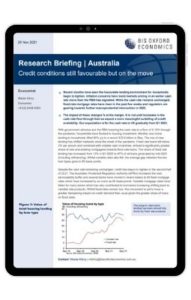Credit conditions still favourable but on the move

Recent months have seen the favourable lending environment for households begin to tighten. Inflation concerns have bond markets pricing in an earlier cash rate move than the RBA has signalled. While the cash rate remains unchanged, fixed rate mortgage rates have risen in the past few weeks and regulators are gearing towards further macroprudential intervention in 2022.
The impact of these changes is at the margin. It is not until increases in the cash rate flow through that we expect a more meaningful curtailing of credit availability. Our expectation is for the cash rate to lift gradually from Q1 2023.
What you will learn in this research report:
- Australian government bond yields have risen over recent weeks. Driving much of this move has been a shift in interest rate expectations, with market participants now expecting a cash rate rise in 2022.
- In response to low interest rates, strong growth in housing credit and increased household indebtedness, there has been an increased focus on macroprudential policies (MPP) both internationally and in Australia.
- The stronger than expected inflation data appears to have accelerated the RBA’s timetable for raising rates, dropping its guidance of rate lift off in early 2024 but holding the line that it expects rates will be on hold well into 2023.
Tags:
Related Services

Post
Eurozone: Little sign of harm from the Red Sea disruptions
The impact of Red Sea shipping disruption on the eurozone economy continues to be limited, in line with our baseline view. Our new Eurozone Supply Stress Indicator suggests that supply pressures have returned to normal following a period of easing in 2023.
Find Out More
Post
GCC: Key themes shaping city economies in the near term
For Gulf cities, the near-term outlook will be tied not only to the global macroeconomic backdrop, but also the progress of the diverse visions and strategies in the region. With the aim to diversify their economies and reduce the dependence on oil, Gulf states continue to invest in the non-oil economy and implement various reforms. That said, oil revenues remain key to funding diversification efforts.
Find Out More